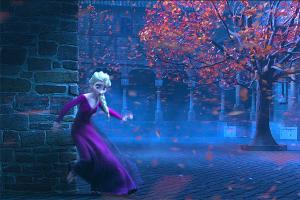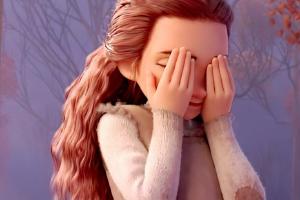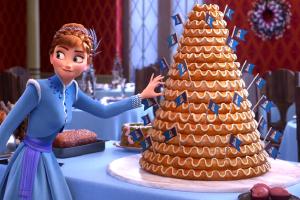Knitted animation in Olaf's Frozen adventure

In Olaf’s Frozen adventure, we can spot quite an unusual scene during the movie. When Olaf sings ‘That time of year’, an animation as if it was made with knitting, as the above picture appears. The representation of texture and color, which looks like real knit, was quite impressive. In this article, we examine how that scene was made. The actual process of making the above scene was previously uploaded as a preceding at the SIGGRAPH2018 conference. It’s just a short two-page paper, so if you’re curious, you can look at it. This article is based on the contents of that paper.
Knitted animation
First, let’s look at how the animating process was described in the paper. Below is from the paper.

“Perhaps the most unique technical and visual challenge in “Olaf’s Frozen Adventure” is the scarf animation sequence. For 25 seconds, the entire screen is covered by a Christmas scarf, complete with stray threads and imperfections. The sequence is accompanied by a musical score, which means careful collaboration between story, music, and animation to achieve the proper timing. All of the patterns and characters woven into the fabric are dynamic, i.e., a knit Olaf jumps across vignettes while singing in sync with the music

“In order to create the over 600 frames of animation, every character pose, and background was painted on a predefined grid pattern in Photoshop, each square of the grid corresponding to an individual thread of the knit scarf.”
“These painted assets were then assembled and animated frame-by-frame via image swapping in Nuke, mimicking an almost stop-motion animation technique. These animated vignettes were then exported to a texture map as an image sequence, and finally applied to the scarf model.”
This wordy explanation might seem complicated, but the principle is simple.
- Draw the pixel art frame-by-frame.
- Combine those pixel arts to generate animation.
- Apply the texture filter.
They say it is a scarf animation, and this is the process of transforming the pixel arts into knitted images. I’m not sure 100%, but to me, it looks like the filter effect in photoshop.
Thus, it seems that most of the time takes on the pixel art parts, not on the part of applying the knitted animation filter. Of course, on the production level, we should make the pixel arts in a natural way and apply proper color correction so that it wouldn’t be that easy.
The paper provides a supplementary video of that knitted animation work, and we can see they are actually doing the pixel arts.
First, draw the pixel arts, then apply the knitted filter to finalize.
Practice
The principle looks quite simple, so let’s practice it.
We will apply the knitted animation to the above Anna’s dragon feet scene.
It is pretty challenging to make pixel arts from scratch, but pixelating some existing videos is quite an easy job. So our strategy is
- Extract images above video frame by frame.
- Apply pixelate filter on each image.
- Apply the knitted effect on each image, then convert it to the video again.
All these steps can be easily done with photoshop.
The output looks as above. Since the original video is 3d animation and I didn’t touch any color correction or palette options, it does not have such a feeling of pixel art. But, if you adjust the size, shape, and color palette appropriately, I think you can achieve some good quality, as shown in the movie.
Summary
The knitted animation in Olaf’s Frozen Adventure is made through frame-by-frame pixel art → animating → applying knitted filter steps.



